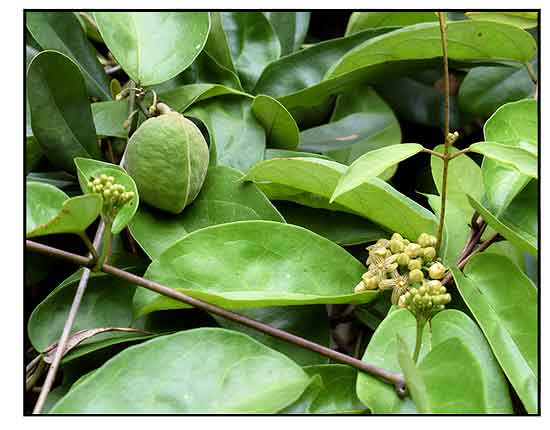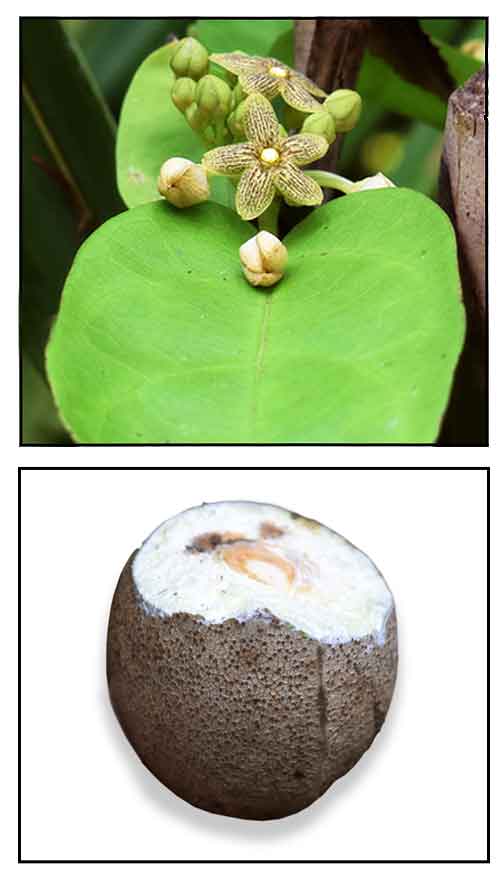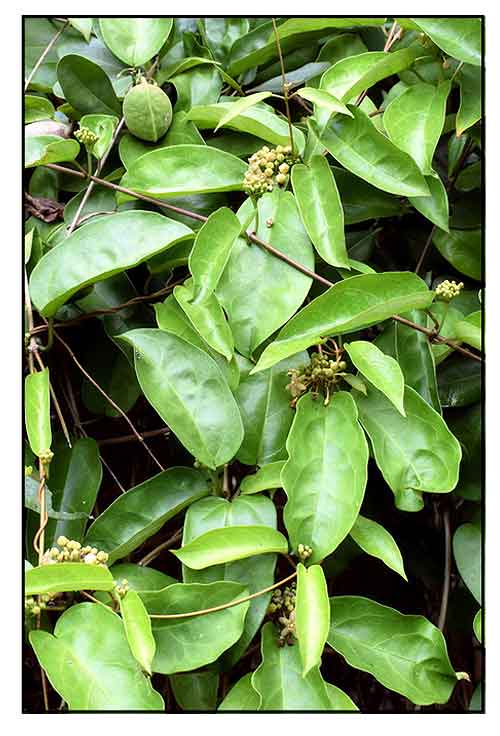 Gen info Gen info
- Sarcolobus is a plant genus in the family Apocynaceae, first established as a genus in 1809.
-
Sarcolobus globosus is a twining shrub native to tropical regions of Asia.
Botany
• The plant is a twining shrub with stout glabrous branches, root-stock thick, and fleshy; roots thick. Leaves are simple, opposite, 3-6x2-4.5 cm, ovate or oblong, thick and fleshy, acute or obtuse at apex, rounded at base. Inflorescence cymose. Flowers small, starry, crowded, in axillary corymbose cymes, 2–3 mm across; corolla purplish, lobes pubescent inside. Follicles brown, 4–5 cm across, sub-globose; seeds are many and flattened. Cotyledones often large, radicle terete. (3)
Distribution
- Native to the
Philippines. (1) (2)
- In tidal streams along edge of mangroves.
- Also native tp Andaman Is., Bangladesh, Borneo, China Southeast, India, Jawa, Laos, Lesser Sunda Is., Malaya, Maluku, Myanmar, New Guinea, Nicobar Is., Sulawesi, Sumatera, Thailand, Vietnam. (1)
Constituents
- Chloroform soluble fraction of crude methanolic extract of bark
yielded total phenolic content (TPC) of 54.21 gm of GAE/100 gm of dried extract. (see study below) (8)
- Study of diethyl ether extract isolated a new rotenoid sarcolobin and a new isoflavone sarcolobone, along with known rotenoids rotenoids tephrosin, 12aα-hydroxydeguelin, 11-hydroxytephrosin, 12a-hydroxyrotenone, 12aα-hydroxyrotenone, 6aα,12aα-12a-hydroxyelliptone, 6a,12a-dehydrodeguelin, 13-homo-13-oxa-6a,12a-dehydrodeguelin, the isoflavone barbigerone and a chromone 6,7-dimethoxy-2,3-dihydrochromone. (9)
 Poison Poison
- S. globosus is U.S. FDA listed as a poisonous plant. The seeds are highly toxic to mammals. Native people of Asia use it to kill dogs and wild animals. It has been shown to effectively kill cats. In Java, there are 19th century accounts to kill tigers. Poisoning in animals manifest with blood in the urine and kidney nephrosis. (3)
-
Bark and seeds contain a poisonous resin, used to poison dogs, wild pigs, and tigers. It has been suggested the extinction of the Javanese tiger was due to use of S. globosus poison by the local population. (7)
- Seeds from one fruit are enough to kill large animals such as elephants, buffaloes, and cattles. Testing in dogs showed serious intoxication with 5 gm of bark powder, with recovery taking a week.(7)
- A crude toxic resinous constituent has been called sarcolobid.
- Tests on a crude glycoside extract suggest a neuromuscular blocking effect which may be dose-dependent or due to a mixture of toxins with presynaptic or postsynaptic effects. The inhibitory effect on smooth muscle contraction is attributed to inhibition of calcium influx. (7)
- Manifestations: Toxicity in cattle may present as debility, incoordination, progressive muscular tremors, pupillary dilatatio, teeth grinding, blanching of visible membranes, rapid pulse, shortness of breath and
coma withint 8 hourse of consuming leaves.
- Fresh coconut water considered an antidote for humans.
Properties
-
Studies have suggested antibacterial, cytotoxic, antioxidant, α-glucosidase inhibitory , membrane stabilizing, thrombolytic, lipoxygenase inhibitory properties.
 Parts used Parts used
Leaves, bark.
Uses
Edibility
- In Malaysia and Singapore, the fruit peel is used for making preserves: steeping it is salt water for three days and subsequetly boiling it in syrup. Also used for making sambal (Indonesian red pepper paste). (5)
- Fruit is candied for consumption, but seeds and resin should be removed. (7)
- Leaves are occasionally eaten with curry. (7) (Caution: Mention is made of leaves being toxic to some degree.)
Folkloric
- No reported folkloric medicinal use in the Philippines.
- Used for treatment of rheumatism, dengue, and fever.
- In Peninsular Malaysia, leaves are ground into a paste with nuts of Aleurites, and the paste is rubbed on joints to treat rheumatism or dengue fever. (7)
Others
- Poison: Leaves are poisonous and used as bait to kill dogs and wild animals. (3) Toxicity of various parts, including leaves, bark and seeds have suggested use as pesticide. (7)
Studies
• Antioxidant / Antibacterial / Cytotoxic / Leaves and Bark: Study evaluated leaf and bark extracts of S. globosus for antibacterial, antioxidant, and cytotoxicity activities. A methanolic bark extract showed highest antioxidant properties by DPPH free radical scavenging (IC50 26.04 µg/ml), reducing efficiency (EC50 77.72 µg/ml), total phenolic content (47.25 mg GAE/g extract), total flavonoid (101 mg GAE/g extract) and total tannin (93.5 mg GAE/g extract). On antibacterial evaluation by disc diffusion bioassay, both bark and leaf extracts showed significant activity against test pathogens: Gram (+) Bacillus megaterium, S. aureus, Micrococcus sp. and Gram(-) E. coli, P. aeruginosa, S. paratyphi, Pseudomonas sp., and proteus sp. Both extracts also showed cytotoxicity activity by brine shrimp lethality bioassaym with the chloroform bark extract exhibiting great cytotoxicity (LC50 19.487 µg/ml) than standard vincristine sulphate (LC50 26.68 µg/ml). (4)
• Cycloeucalenol / α-Glucosidase Inhibitory Activitor / Leaves: Study evaluated the potential antidiabetic attributes of S. globosus leaf extract. OGTT showed dose-dependent reduction in blood glucose levels comparable to glibenclamide. Extract also exhibited notable suppression of α-glucosidase enzyme (IC50 0.407 mg/ml) compared to voglibose (IC50 0.329 mg/ml). Cycloeucalenol, a cycloartane triterpened was isolated, exhibited IC50 of 0.423 mg/ml, which closely approximated the binding affinity of acarbose (-9.7 cal/mol). ADMET confirmed the oral bioavailability and safety profile of cycloeucalenol. (6)
• Membrane Stabilizing / Thrombolytic / Cytotoxic / Bark: Study evaluated a crude methanolic extract of bark of Sarcolobus globosus for total phenol content, cytotoxic, membrane stabilizing, and thrombolytic activities. The extract exhibited significant cytoxicity in brine shrimp lethality bioassay. Membrane stabilizing activity showed 52,73% inhibition of hemolysis of RBC using erythrocyte in hypotonic solution. In thrombolytic screening, the crude ME showed significant thrombolytic activity in human blood specimen. (8)
• Lipoxygenase Inhibitory / Stabilizing / Thrombolytic / Cytotoxic / Bark: Study isolated two rotenoids (villosinol and 6-oxo-6a-dehydrodeguelin), one isoflavone (genistin) and four phenolic glycosides (vanillic acid 4-O-β-d-glucoside, glucosyringic acid, tachioside and isotachioside. All tested rotenoids were shown to have 15-lipoxygenase (15-LO) inhibitory activities. (10)
• Cytotoxicity / Brine Shrimp Lethality of Rotenoids: Study evaluated the brine shrimp toxicity and cytotoxic effect of mangrove plant Sarcolobus globosus. The Et2O and EtOAc extracts showed toxicity to brine shrimp larvae (LC50 1.6 amd 4.0 µg/mL) and Caco-2 cells (IC50 6.7 and 21.2 µg/mL). Three rotenoids isolated viz., tephrosin, sarcolobin, and 12α-hydroxyrotenone showed high toxicity in brine shrimp assay with LC50s of 2.2, 2.8, and 1.9 µM, respectively. (11)
Availability
- Wild-crafted.
|

![]()




 Poison
Poison
